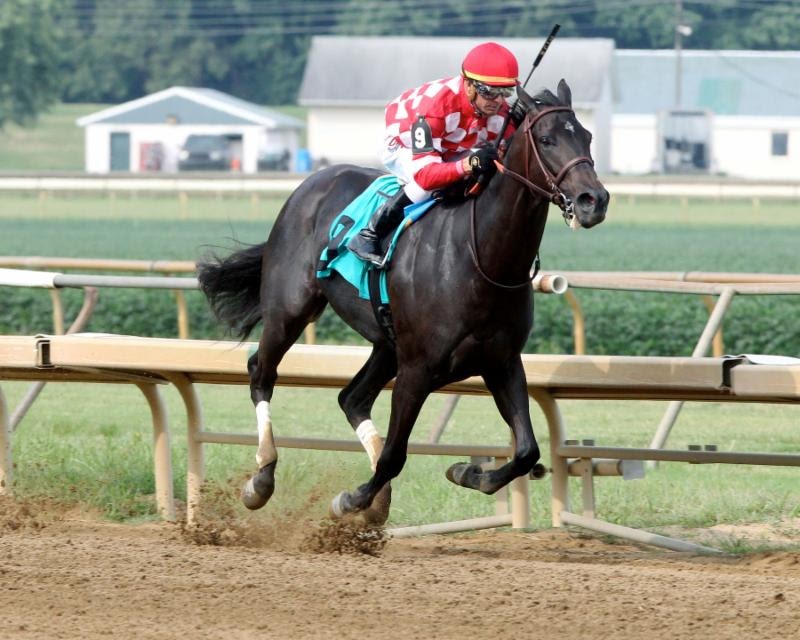
Aqueduct, along with The New York Racing Association, with some help from the weather, did their very best to create a track bias on Saturday, strong enough to compete with any speed highway their West Coast rival Santa Anita ever produced. Saturday was the last big racing day in New York in 2014, and it featured the important and prestigious Grade 1 Cigar Mile. The Cigar Mile is one of those races commercial breeders look to in creating stallions. The supporting stakes featured 2 year old fillies and colts, some of the leading prospects for next year. It would have been nice to see these horses compete on a level playing field. On big days however, that seems to be of minor importance.
It is no secret racetracks have been speeding up their strips on big days for years. It’s old news and we all can see that they do it with regularity. The fractional and final times kick up on those days in all classes of races and the strips often become speed favoring, creating a track bias. We often see track and stakes records go down and we can only surmise the tracks management want it that way and probably think it is good for the game. They are once again missing the boat. Fair and competitive racing without a track bias is way better for the game, bettors, and the history of the sport. Track records broken almost weekly like they were at Gulfstream last year, hardly reflect the true talent and speed of the horses. Further, those inflated track aided times become part of history, speed figures, past performances and ultimately affect all aspects of the game. They don’t even bother to standardize the run ups (the distance horses run before the tele-timer triggers) or even eliminate them altogether.
We can safely conclude tracks find the faster times exciting to the fans, and fail to differentiate them from their core customers, the bettors. Yes we can capitalize on true biases when we recognize them, but I think most of us would prefer to put our skills to the test on level, solid ground. Commercial breeders love the fast times as it helps in justifying higher stud fees. Track and stake records, well that’s even better. Never mind the bettors, do you think they even consider the horse welfare and long term health when they go to work on the racing strip? Faster strips are generally packed harder and can be less forgiving to horses.
A good racetrack superintendent can manipulate a surface in many ways. They can be more difficult to handicap than horses and have a host of tricks. They can make a strip play just about any way they want. Where and how deep they harrow, along with how often, can alter the racing surface. Which lanes, and whether they go clockwise or counter clockwise, can have an effect. How much water, and when and where they put it down, also plays a role. They can keep the dirt loose on top and packed on the bottom or vice versa. They can seal the track as well. The weather factors in and how they do the above can have different results depending on the differing weather scenarios. It’s complicated to some extent, but with experience, a track superintendent can get a racetrack to be very cooperative to his desires.
Saturday at Aqueduct we saw what is commonly described as a golden rail. The track was speed favoring as well. A combination of a golden rail on a speed favoring track has an effect on the outcome of the races. This combined bias was so profound Saturday that Cigar Mile winning rider Martin Pedroza mentioned it in his post race interview. There was no way a rider as sharp and savvy as him was going to miss something so profound. He went so far as to say he watched it from the jockeys’ room before he rode, and visibly noticed when he got on the track and even mentioned it to his pony girl, who agreed. It was no secret. Prior to the running of The Cigar Mile, twitter blew up with people calling Private Zone the winner. Just as crucial as a bias like that helping certain horses, it hinders horses trying to keep to their style and being forced to run against it. Secret Circle did a face flop coming out of the gate and pretty much lost any chance he had over that track. I suspect rider Joel Rosario, conscious of the track, was a bit gate anxious and wanted to get out fast and get over, thus possibly causing the break mishap. Nonetheless, there was hardly a chance Martin was going to give up that golden rail and not use Private Zone’s speed to go gate to wire on a track he knew would help every step of the way.
How to recognize track bias
Another problem with track biases, is how to recognize them. That isn’t always as easy as it sounds. You have to be a good handicapper with a good opinion to recognize a true bias from a false one. When you spot one early, it is like spotting a tell in poker, and you can work it to your advantage. If you think you have one that really isn’t, it can be a very humbling experience. I use my program. As I watch the races I write down the fractions and where the winner and sometimes second place horse comes from. Biases and trends reveal themselves quickly that way. However, you have to be wary of false ones. You weed those out by knowing if the horse who won was supposed to win and wasn’t really aided by the track. A true bias will make a horse lose who may have won and a horse win who likely would have lost.
On Breeders’ Cup Friday in 2013 we saw a strong track bias at Santa Anita. It was so profound Twitter was buzzing about it, and even owners and trainers were complaining. To their credit, albeit they should not have had to, Santa Anita had the track worked on and corrected by Saturday when it played very fair. This year, things at the Breeders’ Cup were a little different. Friday saw the track play very honest. It rained Saturday and for whatever reason, the track changed for Saturday, but was it truly a track bias? That is an interesting question. Most people seem to think it was, very much so. I’m not quite that sure. Most of the early races, if not all, were won by horses who figured to win and also happened to be front runners. That changed, however, when Take Charge Brandi went wire to wire at 60-1 in the Breeders’ Cup Juvenile Fillies. She wasn’t “supposed’ to win. She was a good horse early in her two year old season and had been on my watch list since her debut, but she had gone off form, and hadn’t progressed. Not until that Saturday anyway. She made a strong case for no bias, however, when she came back as a bet against, due to a bias aided win, but won The Delta Princess anyway, again in front running fashion. On the same card, in The Delta Jackpot, Ocho Ocho Ocho, who had gone wire to wire on Breeders’ Cup Saturday, also did the same going gate to wire. Now we have two biased aided winner from that card coming back to win stakes. Texas Red won The Juvenile Colts from last, and Judy The Beauty won her race from just off the pace. Nobody wins like Texas Red did against the bias even if they go fast and the race collapses. All things considered, Santa Anita did right this year, and the track was as good as they could get it given the weather. It was sealed early to protect it as it dried out during the day but that was probably the best way to go.
There was no such doubt Saturday at Aqueduct. You had to be on the rail to win, and if you had speed, that was a big help. Speed on the rail was not beatable. Frosted, a well-regarded two year old trained by Kieran McLaughlin, was good enough to overcome the 12 hole in the Remsen, but not the golden rail and speed. He got into second and contention for the win, but could not down Leave The Light On who was on the engine and the rail.
At Churchill Downs on Saturday they ran their two year old stars of tomorrow card. The best two year old was not in either of the stakes however. That spot is reserved for the massive and fast Dortmund. I’m not the early hype or bandwagon type but this looks like a racehorse to me. If they ran the Derby last Saturday he would have won it.
As expected, California Chrome dominated an out classed field in a diluted Hollywood Derby. He looked impressive drawing off but he was “supposed” to against a group like that. I would have liked to see him in The Clark at Churchill Downs on Friday. That would not have been a walk in the park.
High 5
Regular west coaster Martin Pedroza came east again and took The Cigar Mile with Private Zone. He gets a high five for watching those early races and knowing the track come race time. The man is a pro.
Florent Geroux also gets a high five. He rode Red Rifle for Todd Pletcher in The Hawthorne Gold Cup and as we have written the past few weeks, Florent has really taken his game to a new level.
Our very own Carson Sullivan, who we profiled right here when he took his tack out west is riding lights out at Golden Gate. High Five Carson.
Low 5
A popular racing column blogger, who shall remain nameless, compared California Chrome as a turf horse to John Henry this morning. Now to be PC we are forced to hear and purport to respect many an opinion. There comes a limit, but then again, can that even really be called an opinion. Just take the pens and keyboard away. They may hurt themselves.
Horse to Watch
I always respect an off the pace two year old sprint debut winner, who can rally off the pace just as strong going long in their second start. Most times they don’t have that same punch first time routing. No Fault of Mine did not have that problem. She went from the debut maiden breaker on synthetic, where she came off the pace, to The Golden Rod where she again rallied for a strong second. She can run and will continue to improve.




